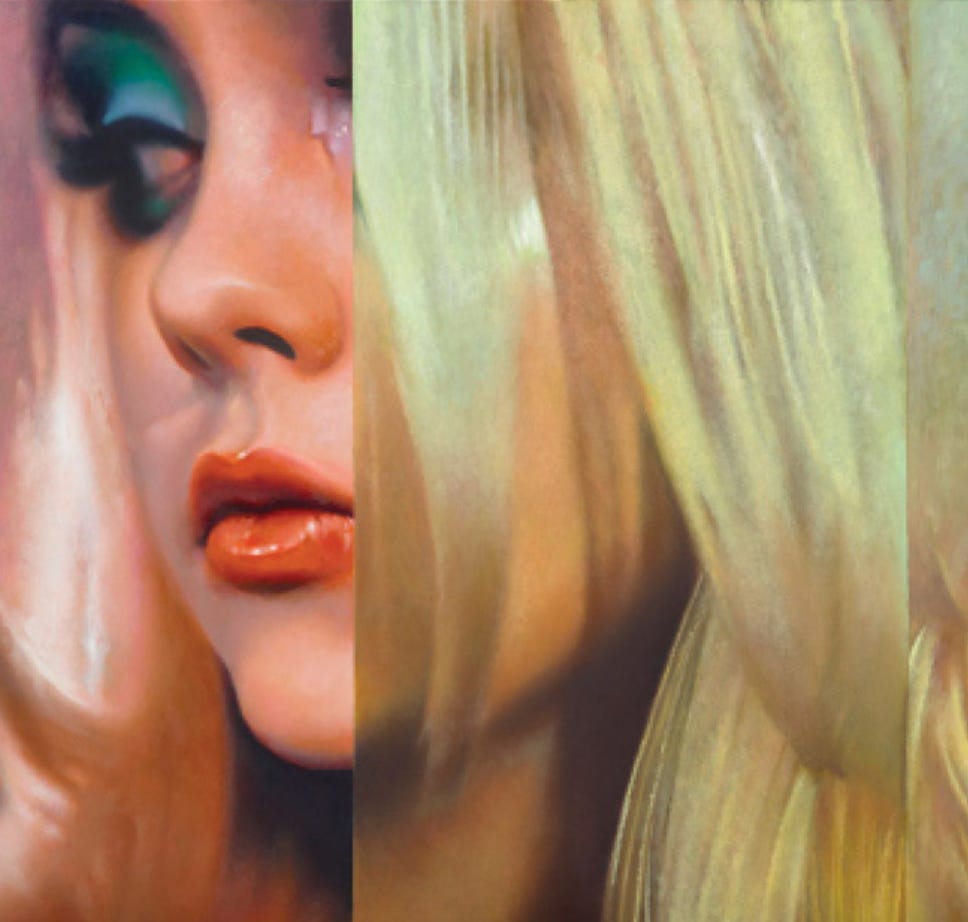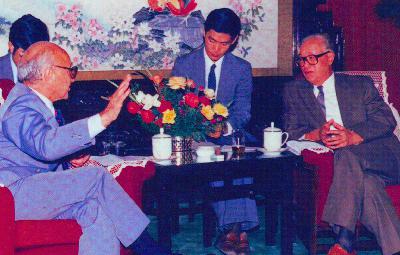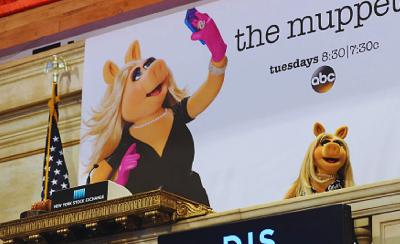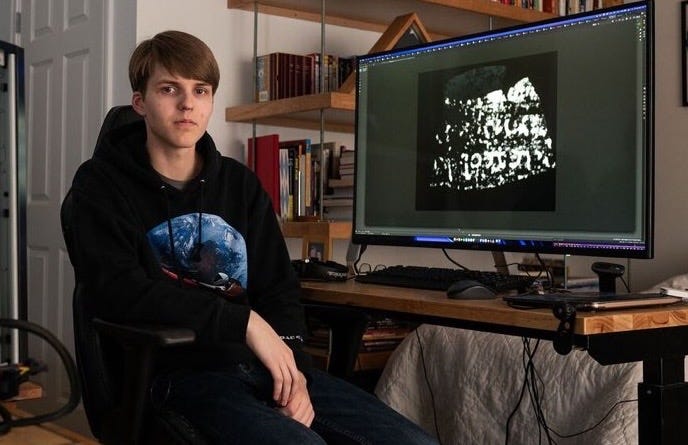Discover The Culture Journalist
The Culture Journalist

The Culture Journalist
Author: The Culture Journalist
Subscribed: 31Played: 655Subscribe
Share
© Emilie Friedlander, Andrea Domanick
Description
Cathartic conversations about culture in the age of platforms, with Emilie Friedlander and Andrea Domanick
theculturejournalist.substack.com
theculturejournalist.substack.com
92 Episodes
Reverse
Hey pals. A little housekeeping: We keep full-length episodes like this one free, because we want as many people as possible to be able to hear them. But every episode we put out takes at least 20 hours to produce, from researching and booking to script writing, recording, editing, and marketing — and if you love this pod, we could use your help in keeping this project economically sustainable so we can keep churning out episodes like this one for years and years to come.If a paid subscription ($5/month!) isn’t on the table for you right now, we’ve introduced a new tipping feature where you can throw us a couple bucks to let us know that you’re enjoying what we make. You can think of it as tipping a barista for your morning cup of coffee — only instead of a cup of coffee, you’re tipping us for an hour or more of stuff that you download into your brain. It’s been a rough couple of weeks for freedom of speech in America, from from Jimmy Kimmel’s suspension and reinstatement at ABC, to Trump’s executive order labeling Antifa a domestic terror group, to right-wing doxing databases targeting private citizens for Charlie Kirk wrongspeak. Here to help us make sense of the larger political and economic currents that have led us to this moment is Chicago-based journalist Adam Johnson, co-host of the long-running media criticism podcast Citations Needed, creator of The Column on Substack, and author of a piece for In These Times titled “The Trump admin is brazenly exploiting Charlie Kirk’s killing to silence dissent. Will Democrats take notice?”We break down the Kimmel saga — which coincided with a deportation order against Palestinian activist Mahmoud Khalil — and how the Trump administration is using Kirk’s assassination to push a broader agenda to erode liberal institutions, silence political opposition, and get corporations to fall in line. We also dig into the right’s overt embrace of so-called “cancel culture” tactics, backed by the full weight of the state — and how Democrats helped set the stage for this moment failing to defend the speech rights of their left flank. Finally, we examine how the media industry appears to be on the verge of a conservative “vibe shift,” from Bari Weiss’ rumored rise at CBS to the Ellison family’s powergrab over Paramount-Skydance and TikTok — and what standing up for free speech, and even doing one’s job as a journalist, could look like in the years to come.For access to our monthly cultural weather report, our CUJOPLEX Discord, and other bonus perks, become a paid subscriber.Read Adam’s piece “The Trump Admin Is Brazenly Exploiting Charlie Kirk’s Killing to Silence Dissent. Will Democrats Take Notice?” at In These Times.Subscribe to The Column and listen to Citations Needed. This is a public episode. If you'd like to discuss this with other subscribers or get access to bonus episodes, visit theculturejournalist.substack.com/subscribe
CUJO is a podcast about culture in the age of platforms. Episodes drop every other week, but if you want the full experience — including access to our CUJOPLEX Discord and our eternal parasocial friendship — we recommend signing up for a paid subscription.Paid subscribers also get access to The Weather Report, a new monthly episode series where we take stock of where the cultural winds are blowing and tell you what’s rained into our brains. In the latest installment, cyberethnographer Ruby Justice Thelot joins us to wax philosophical about the Labubu craze, matcha and “performative male” discourse, and why politicians are lifting weights in public. It’s easy to get the impression these days that the traditional media industry is abandoning cultural criticism. Over the past few months, outlets like The New York Times, The Washington Post, and The Chicago Tribune have been reassigning or letting go of veteran film, music, and theater critics, leaving some to debate what impact, if any, written criticism still has on the culture at large. Bucking this trend (and pretty much all mainstream media logic) is The Metrograph, a new biannual print magazine about cinema from the eponymous repertory theater in New York City’s Chinatown. It’s long, proudly niche, intentionally disconnected from the news cycle, and available only in print—with the goal of offering deep film fans an experience they won’t be able to find online, while inviting a new generation of people into the culture. The recently released second issue includes a 42-page dive into Paul Morrissey’s archives, author Gary Indiana’s favorite films (RIP), a history of the Japanese pink film, a “cinemap” of Belgrade, and a comic about Jerry Lewis’s infamous lost film The Day the Clown Cried. The cover, which we’ve cropped for this episode’s artwork, features a painting by artist Louise Giovanelli inspired by Christina Ricci’s character in Buffalo ’66.Senior editor Annabel Brady-Brown (formerly of Australia’s Fireflies Press) and editor-at-large Nick Pinkerton (film critic, screenwriter of The Sweet East, creator of the Substack Employee Picks, and a former coworker of Emilie’s at Kim’s Video) join us to discuss the past, present, and future of independent film criticism—and what it means to make a magazine for cinephiles in 2025. We also discuss why younger people in NYC seem to be gravitating back to the movies these days, and how the hyper-IRL, videostore-centric independent film culture of 20 years ago is a good template for what that might look like in the 2020s. Finally, we shout out some of the directors, movies, and micro publications that are making right now such an exciting time for cinema in NYC — and the repertory theaters and video stores we love around the world that are keeping the old Kim’s Video spirit alive.Issue 2 of The Metrograph is out now. Buy it here, or at an independent book or magazine store near you.Read more by our guests:”Less rock, more talk: On Paul Morrissey, Pier Paolo Pasolini, Ezra Pound, ‘political’ art, and 1988’s ‘Spike of Bensonhurst’” by Nick Pinkerton (Employee Picks) “Sunshine, lollipops and rainbows: On the subversive pleasures of Agnès Varda‘s Le Bonheur” by Annabel Brady-Brown (The Metrograph) This is a public episode. If you'd like to discuss this with other subscribers or get access to bonus episodes, visit theculturejournalist.substack.com/subscribe
CUJO is a podcast about culture in the age of platforms. Episodes drop every other week, but if you want the full experience — including access to our CUJOPLEX Discord and our eternal parasocial friendship — we recommend signing up for a paid subscription.Paid subscribers also get access to The Weather Report, a new monthly episode series where we take stock of where the cultural winds are blowing and tell you what’s rained into our brains. In the first installment, we wax philosophical about Ari Aster’s Eddington, the future of search, and the alleged returned of Butt Rock. These days, it feels like the web is becoming… less of a web. Websites aren’t getting visitors anymore, employees are worried that they’re going to be replaced by AI agents, and the search tools we used to rely on to pull up the information we need are deliberately enshittifying themselves. It’s like the internet as we know it — fundamentally, a thing that connects people with other people — is being swallowed up by AI and smooshed down into the cramped, impersonal space of a chatbot interface, whether we like it or not.Or, as New York Magazine tech journalist John Herrman recently put it, “The World Wide Web … has been going through something akin to ecological collapse.” John has been keeping close tabs on these developments in his excellent column “Screen Time,” where he recently reported on the emerging field of generative-engine optimization, or GEO. Think: SEO, but for the AI-consolidated internet.We invited John on the show for a wide-ranging conversation about the strange new chapter of the internet that is materializing before our eyes—and what our experience of the web might look like a world where conversational AI becomes our main portal to the digital realm. We discuss the shift from SEO to GEO, why we’re all reading Reddit a lot more now, and what we stand to lose (and, in some cases, gain) in a world where we summon our information from chatbots.Finally, we get into what New York Times writer Mike Isaac is calling the dawn of Silicon Valley’s “Hard Tech” era: a vibe shift away from the consumer-focused, employee-friendly, optimistic culture of the 2010s to the more cutthroat, bossist, AI and data center-obsessed tech culture of the present.Follow John on BlueskyRead “Screen Time” at New York Magazine’s Intelligencer More by John: “What’s the deal with GPT-5?”“SEO is dead. Say hello to GEO.”“The AI boom is expanding Google’s dominance” “Why you are reading Reddit a lot more these days”“At work, in school, and online, it’s now AI versus AI” This is a public episode. If you'd like to discuss this with other subscribers or get access to bonus episodes, visit theculturejournalist.substack.com/subscribe
What do mullets, SpongeBob stick-and-pokes, and foil-wrapped sandwiches have in common? According to this week’s guest, London writer Clive Martin, they’re all hallmarks of a new type of food-obsessed, young urban professional that Clive calls the “defining person-type of 2025.” You know the type: people who queue up around the block for hours for a taste of the latest Instagram-viral, cartoonishly gigantic Italian sandwiches, in a neighborhood where the old school Italian sandwich shops are being displaced. Clive calls these people “The Normans,” after a North London cafe-restaurant they frequented for its loving homages to greasy-spoon staples like chippy teas and chicken fingers. But it’s a subculture that transcends international borders, at least in the English speaking world: a distinctly bro-y strain of contemporary foodie culture fueled by viral images of oozing cheeseburgers, indie rock music, Anthony Bourdain hagiography, and upscale, farm-to-table recreations of working class and immigrant food traditions. The plan their weekends around new eateries, walk around wearing restaurant merch, and secretly wish they could they could quit their fintech job and start over as Carmy from The Bear. Clive is a former colleague of ours from VICE, and one of our favorite observers of contemporary culture—especially when it comes to cities and gentrification. We brought him on to discuss his article for VICE, titled “Meet the Normans,” and how food supplanted music, film, and art as the dominant mode of cultural consumption among young people. We also get into the subculture’s nature as a kind of masculine reaction to other strains of millennial yuppie food culture, how both the food internet and the bro internet are reshaping our cities, and how the rising cost of living is pushing the gentrification cycle into exurban areas like Upstate New York, Margate, and Joshua Tree. Finally, we share some of our favorite, decidedly not-Norman restaurants in London, Philly, and LA that are still hanging on.Follow Clive on X @clive_mart1nRead more by Clive:“Urban sprawlers: How city folk ruined the countryside” (The Face)“Ketamine, crime, and chaos: Life in a London party slum” (VICE)Other relevant reads:“Welcome to Neo New York, where everything feels old school but isn’t” by Emilie Friedlander (VICE)“We are all foodies now” by Steven Phillips-Horst (Spike Art) This is a public episode. If you'd like to discuss this with other subscribers or get access to bonus episodes, visit theculturejournalist.substack.com/subscribe
Join us in Philly on Tuesday, 29 for a special book talk with this week’s guest, Jeff Weiss, co-presented by CUJO and Lot 49 Books. The event kicks off at 7 pm, at Fishtown’s Neon Clown Dream Lounge — and will feature Jeff in conversation with Emilie, Drew Millard, and Sadie Dupuis, followed by a book signing, a Britney-themed DJ set by Domino Dancing, and, rumor has it, Britney-themed drinks. Admission is free, but you can pre-order Jeff’s book here to support him and one of the city’s best independent bookstores.As a younger generation obsesses over Canon PowerShots, low-rise jeans, flip phones, Von Dutch, and other relics of the Y2K era, it’s easy to forget that the 00s were actually a pretty terrible era for pop culture. And while some of that has to do with aesthetics (looking at you, Boho Amnesia Belt), it was especially true when it comes to media. Think: award-winning news anchors contemplating pop stars’ virginities and making them cry on primetime TV; reality shows about celebrities in rehab funded by commercials for dubious diet pills; supermarket check-out aisles lined with magazines asking whether your favorite actor was “hot” or “not.”Few people got to know that world quite like music writer, friend-of-the-pod, and Passion of the Weiss founder Jeff Weiss, and he just published a book about it. It’s called Waiting For Britney Spears: A True Story, Allegedly, and it’s a semi-fictional account of Jeff’s years working as a young tabloid reporter in the early 2000s, roving the streets of LA with a paparazzi buddy in pursuit of the rich and famous — and the concurrent arc that saw Britney Spears go from America’s Sweetheart to Vegas party girl to conservatee.You could call it a work of fiction, written as a memoir; a work of non-fiction in the spirit of Joseph Mitchell and the Beat poets; or, as Jeff has described it, “a one-person referendum on the impossibility of knowing the exact truth about anything — especially anything refracted and distorted through the lens of electronic media.” Either way, it’s as much about Britney as it is about the glossy, Ed Hardy-adorned last days of pre-internet media and pop culture at the turn of the millennium — and how that time set the stage for the ruthless, gossip-obsessed cultural climate of the present. Jeff joins us to talk about his days as a gossip reporter, and why he chose this experimental format rather than a straightforward biography. We also get into how these experiences informed his understanding of the morality (and amorality) of journalism, how the tabloid era paved the way for our current moment in political media, and why a new generation of young people seems so nostalgic for the fashion and music of the early 2000s.CUJO is a podcast about culture in the age of platforms. For access to paywalled episodes and an invite to our Discord, become a paid subscriber.Buy Waiting for Britney Spears, and follow the book’s Instagram account. There’s also an official playlist. Follow Jeff on X and check out his new podcast, The Truth Hurts. This is a public episode. If you'd like to discuss this with other subscribers or get access to bonus episodes, visit theculturejournalist.substack.com/subscribe
With a catalog full of art house favorites like The Witch, Spring Breakers, Moonlight, and Uncut Gems, it’s hard to deny that A24 occupies a unique position in the zeitgeist. In a Hollywood landscape that can feel like it’s becoming more risk-averse by the year — see our recent episode with Andrew Dewaard on his book Derivative Media — the artist-forward distributor and studio has become synonymous with a dream that, to many American cultural producers, feels increasingly remote: the conviction that one can doggedly put quality art out into the marketplace and see it actually succeed.But is A24 singlehandedly saving American cinema, or is that just a carefully crafted illusion, more a testament to the importance of smart brand positioning than to the actual quality of the films in its catalog? We brought on the Las Vegas-based writer and critic Nicholas Russell, author of an excellent essay for Dirt called “The Popular Alternative: the State of A24,” to discuss how the company evolved from an upstart indie film distributor to a studio and lifestyle brand in the mold of Disney — albeit one for adults who pride themselves in being savvy cultural consumers.We talk about how the company successfully commodified the idea of being “a cinephile,” the similarities between the A24 cap and the New York tote, and what Nicholas describes as the longstanding “tension between A24 the studio and A24 the startup” — one recently complicated by a $100 million cash injection from Josh Kushner’s Thrive Capital, a major investor in OpenAI. We also try to break down the ineffable A24 “feel” (including the aesthetic elements and political themes the company tends to foreground, and shy away from) and consider the rise of Neon — the distributor behind movies like Parasite, Anora, and How to Blow Up a Pipeline — as the “other popular alternative.”Follow Nicholas on X and SubstackRead more by Nicholas hereRecommended reading about A24 and the Hollywood system from Nicholas:"The Life and Death of Hollywood" by Daniel Bessner (Harpers)"A24's Risky Hollywood Moment" by Felix Gillette (Bloomberg)Hollywood: The Oral History by Jeanine Basinger and Sam Wasson (Harper Collins) This is a public episode. If you'd like to discuss this with other subscribers or get access to bonus episodes, visit theculturejournalist.substack.com/subscribe
This is a free preview of a paid episode. To hear more, visit theculturejournalist.substack.comThis is a free preview of a subscriber-only episode. If you sign up for a paid subscription between now and July 4, we’ll give you 50% off.For as long as any of us can remember, the NBA has been the cultural North Star of the United States. But according to Ock Sportello, author of a viral Substack article called “Toward a Unified Theory of Uncool,” the league has become a microcosm of the ways that economic risk aversion and image production in the age of social media are rendering the culture at large… increasingly swagless. To celebrate the final weekend of the NBA season, Emilie and boyfriend-of-the-pod/co-host of the excellent new show Macho Pod Drew Millard brought on Ock to discuss how “aura” replaced “coolness,” the erasure of regional identity in the age of globalization, and what the basketball superstars of 2025 have in common with the West Village Girls.
From tariffs on foreign goods to scaling back on US military and humanitarian aid abroad, it’s clear that Trump is intent on moving the country in a more protectionist direction. But what does that look like for pop culture? Think: Kendrick’s “Not Like Us” as an anthem for our time, versus Drake collaborating with lesser-known grime and Afro-house producers during the Obama years.Critic Jaime Brooks — who you may also know for her work in musical projects like Elite Gymnastics and Default Genders — recently wrote an epic essay exploring the geopolitics of music and entertainment in 2025. The piece is called “Notes on the Canzukian Schism,” and it’s an eye-opening look at the ways the European social welfare system, US military policy, and libertarian free market evangelism have shaped our experiences as both consumers and producers of pop culture over the past century.Jaime joins us to discuss how her Canadian upbringing — much like Marshall McLuhan’s and Drake’s — gave her a distinct perspective on media and culture in the Anglosphere. She takes us through the history of radio in the UK and US, and how it set the stage for both the genesis of Western pop music and the perennial question of whether art should be funded by markets or the state. We also talk about how the “poptimism vs. rockism” debate overlooks the material realities of the music industry, how being online and being literate have become two entirely separate things, and why community radio may be the last viable path forward for culture.Want to continue the conversation? For access to our member-only Discord (and the full edition of this episode), sign up for a paid subscription.Subscribe to Jaime’s Substack, The Seat of LossRead more by Jaime“American Sajaegi” (The New Inquiry)“The Summer of Love and the Holy Fair” (The New Inquiry) This is a public episode. If you'd like to discuss this with other subscribers or get access to bonus episodes, visit theculturejournalist.substack.com/subscribe
In his new book, What’s Left: Three Paths Through the Planetary Crisis, writer Malcom Harris examines what is probably our most pressing existential paradox: Both individually and as a society, we’re all so caught up in the struggle to survive under capitalism that we’ve become incapable of taking decisive action to reduce our reliance on carbon and ensure our collective survival. Fortunately, as Malcom sees it, our fate isn’t sealed just yet. And What’s Left lays out, clearly and accessibly, what he sees as the three remaining options for saving the world.Malcolm joins us to talk about those strategies — which he calls marketcraft, public power, and communism — and why solving the climate crisis requires people from across the left pursuing all three of them in tandem. We also get into why more mainstream political philosophies — like the notion of “Abundance,” popularized by Ezra Klein and Derek Thompson and championed by centrist Democrats like Cory Booker — won’t help, largely because of a failure to engage with class politics.Finally, we zoom out to contemplate what political opposition even looks like in our increasingly inhospitable environment for free speech. Will the left will remain fragmented between Boomers shouting “Hands off NATO” at public protests while college students get arrested for peacefully protesting the atrocities in Gaza? Or is a broader coalition possible?Want to continue the conversation? For access to our member-only Discord (and all our bonus episodes), sign up for a paid subscription.Order What’s Left: Three Paths Through the Planetary CrisisFollow Malcolm on XRead more by Malcolm:“What’s the matter with Abundance?” (The Baffler) This is a public episode. If you'd like to discuss this with other subscribers or get access to bonus episodes, visit theculturejournalist.substack.com/subscribe
During the pandemic, it seemed like the internet, and specifically TikTok, was coughing up one fringe aesthetic after the next: Cottagecore! Trad Cath Coquette! Old Money! Coastal Grandmother! And of course, our personal fave, Dark Academia. We even did a whole episode on it, as part of a larger examinatin of post-pandemic aesthetics. Fast forward to today, and the churn of social media-born aesthetics seems to have slowed somewhat, leaving behind a landscape that feels more fragmented and difficult to parse. So we’ve brought back our guest for that episode — style writer, trend forecaster, and bonafide Cool Girl Biz Sherbert — to give us a lay of the sartorial land. Along with continuing to co-host the influential fashion and culture podcast Nymphet Alumni, and writing for places like The Face and AnOther Magazine, Biz recently launched a new publication called American Style on Substack (subscribe!), which she says is about “what people are really wearing and why.”If you’re a CUJO subscriber, you already got a little taste via our Coachella collab with American Style a couple weeks ago. Either way, you’re in for a treat: Biz joins us to talk about American Style’s origin story and what’s she’s learned from documenting what young people are wearing out in the real world, at places ranging from a Deftones concert in Atlanta, to Disney World in Orlando, to a rave in North London. We also get into the state of countercultural and subcultural fashion in 2025; why men and boys seem, for the first time in a long time, to be leading the style conversation; the role that festivals like Coachella play in the wider image-making ecosystem; and the strange staying power of the festival cowgirl.Subscribe to American Style and follow Biz on Instagram (fka @marcfisherquotes). Listen to Nymphet Alumni on your pod platform of choice. This is a public episode. If you'd like to discuss this with other subscribers or get access to bonus episodes, visit theculturejournalist.substack.com/subscribe
Franchises, reboots, crossovers, live-action remakes, interpolations… Why does the entertainment industry keep churning out content that is derivative of something that came before, like Nicki Minaj rapping over “Barbie Girl” at the end of the Barbie movie on an endless loop? According to Andrew deWaard, a professor of media and popular culture at UC San Diego, it’s because of Wall Street. In his brain-expanding new book, Derivative Media: How Wall Street Devours Culture, Andrew pulls back the curtain on how popular culture has become derivative in a deeper, more insidious way: it’s private equity buying up entire song catalogs, activist hedge funds staging hostile takeovers of entertainment conglomerates, and the cultural industries getting consumed wholesale by the financial sector — actual derivatives trading included. That wave of financialization is having an increasingly palpable effect on what we see and hear when we open up apps like Spotify and Netflix — not just in terms of the kinds of works that get funded, but increasingly, in the character of the works themselves, leading Andrew to posit that “the stock exchange has been embedded within the media text.”Andrew joins us to talk about how finance-world strategies impact both the companies that fund the culture we consume and the labor of those who produce it — and how they result in an entertainment landscape that is increasingly inhospitable to taking big risks. And we get into how the logic of the derivative has become embedded in media products themselves, from Jay Z turning lyrical wordplay into a champagne empire, to The White Lotus casting K-pop star LISA.Order a copy of Derivative Media — or download an open-access PDF for free.Read more by Andrew:The Cinema of Steven Soderbergh: Indie Sex, Corporate Lies, and Digital Videotape (Columbia University Press)“Independent Canadian Music in the Streaming Age: The Sound from above (Critical Political Economy) and below (Ethnography of Musicians)” (Popular Music and Society) This is a public episode. If you'd like to discuss this with other subscribers or get access to bonus episodes, visit theculturejournalist.substack.com/subscribe
Since Trump took office in January, you may have picked up on a certain, shall we say, visual vibe. Think: AI slop memes, gilded neoclassical decor, men clad in dark suits and red ties, women decked out in high heels and flowing hair—not to mention an ambiguous blend of plastic surgery and contoured make-up that the Hollywood Reporter recently dubbed “Mar-A-Lago Face.”If you’ve noticed some of these recurring themes, you’re not alone. The arts journalist and critic Carolina Miranda has been keeping tabs on the intersection of visual culture, society, and politics for years, and she recently came up with a name for the look and feel of the current administration: Trump Trad. Her recent column for the Washington Post, “Welcome to the Era of Trump Trad,” is worth a read—and it’s the first in a monthly series providing an ongoing aesthetic analysis of the Trump era, which is among her new endeavors since taking a buyout from her longtime role at the LA Times last year. (She also writes the Arts Insider newsletter for KCRW, which Andrea edits.)Carolina joins us to explain the three core pillars of Trump Trad: a yearning for the past (architecturally and otherwise), traditional gender roles, and—fascinatingly—professional wrestling. We also get into how to reconcile all the trad-ness with this administration’s simultaneous embrace of Silicon Valley and AI, whether or not Biden or Kamala aesthetics exist, and how Trump’s obsession with taking control of the programming at the Kennedy Center and issuing executive orders about architecture fits in with his politics of resentment against so-called “cultural elites.”Want to continue the conversation? For access to our member-only Discord (and all our bonus episodes), sign up for a paid subscription.Sign up for Carolina’s KCRW newsletterRead more from Carolina:“How Silicon Valley boys came to rule politics” (WaPo)“Influencer Jenny69 calls herself a ‘buchona.’ How a narco-inspired style came to rule social media” (LA Times) This is a public episode. If you'd like to discuss this with other subscribers or get access to bonus episodes, visit theculturejournalist.substack.com/subscribe
Today we explore how many of the habits and customs we associate with American bourgeois life — religiously reading the Sunday Times, buying organic produce, building your entire identify around excelling at a career you love, etc. — stem from one generation in particular. Friends, we’re talking about the yuppies, that notoriously status-obsessed, hyper-educated cohort of young urban professionals who came to cultural prominence in the ’80s and ’90s, setting off a series of transformations in our cities, media, and consumer culture that we’re still witnessing to this day.It’s easy to see the Boomer worldview as a reflection of the fact that they had it much easier than us Millennials, economically speaking. But a new book called Triumph of the Yuppies: America, the Eighties, and the Creation of an Unequal Nation, by Philadelphia journalist and author Tom McGrath, subtly challenges that idea, reframing the yuppie obsession with money, achievement, and unimpeachable good taste as a response to the rough economic headwinds of the 1970s and ’80s. Along the way, it explores how yuppiedom was equally a reaction to suburban post-war monoculture — and perhaps most perplexingly, a kind of impossible attempt to reconcile a newfound love of capitalism with the egalitarian values of the hippie era.Tom joins us to discuss the yuppie origin story and the historical factors that rerouted a generation from protesting the Vietnam War to working on Wall Street. We get into who — and what — the yuppies were rebelling against, and how their emphasis on not just consumption, but consuming the right things, laid the blueprint for everything from urban gentrification, to contemporary food culture, to the news and television we consume.We also talk about whether or not the yuppie still exists — perhaps in the form of Millennials? — and, of course, where Trump, then and now, fits into all of this.Purchase Triumph of the Yuppies.Follow Tom on Substack. This is a public episode. If you'd like to discuss this with other subscribers or get access to bonus episodes, visit theculturejournalist.substack.com/subscribe
The Culture Journalist is a podcast about culture in the age of platforms. Episodes drop every other week, but if you want the full experience — including bonus episodes and our eternal parasocial friendship — we recommend signing up for a paid subscription.Paid subscribers also get access to CUJOPLEX, a private Discord server and online hangout zone where independent culture fans who like talking about things like creative economies, media theory, current events, and the future of entertainment and journalism can congregate, share links, and talk about the news of the day.Climate disasters like the Los Angeles wildfires in January and Hurricane Helene last fall aren’t just laying bare the realities of global warming; they’re exposing the hidden dynamics of another kind of ecosystem: Media and information.From journalists compiling mutual aid spreadsheets to country music radio shows that became community message boards when the internet went out, these calamities are shining a spotlight on the evolving role of journalism and how we access information. They’re also raising new questions about what that information should be, whose responsibility it is to vet and disseminate it, and what the media of the future might look like — you know, as climate disaster becomes a more regular feature of life.There’s a lot to unpack here. So we’ve tagged in two media experts who, like Andrea, are based in LA and have had to confront climate disasters firsthand. Matt Pearce is a former Los Angeles Times reporter (and co-founder of its first union) with experience covering everything from hurricanes to internet culture; these days, he writes a Substack newsletter on the state of local news and media policy and is a senior policy advisor for the nonpartisan think tank Rebuild Local News.Longtime listeners might remember Emma Kemp from one of our earliest episodes on ghost kitchens. She’s a researcher and writer and assistant professor at the Otis College of Art and Design who specializes in environmental media studies, and co-founder of the non-profit land conservation coalition No Canyon Hills.Matt and Emma join us to talk about their experiences on the ground as both media consumers and producers during the wildfires; the sources of information that became essential, and the sources of information that just sort of fell away; the limitations (and opportunities) of AI in a crisis; and how climate disasters will transform what both traditional and non-traditional media look like.Follow Matt on Substack and X. Check out his pieces on Watch Duty and on AI use during the wildfires.Check out more from Emma on her website and at No Canyon Hills. She also sells chickens, eggs, and coop supplies over at Party Fowl. The cover of “California Dreaming” by Jarvis Cocker featured in this episode was purchased from the LA fire benefit compilation Los Angeles Rising. Check it out, along with a collection of other compilations released to fundraise for wildfire relief, here. This is a public episode. If you'd like to discuss this with other subscribers or get access to bonus episodes, visit theculturejournalist.substack.com/subscribe
This is a free preview of a paid episode. To hear more, visit theculturejournalist.substack.comFrom AI song generators like SUNO and Udio to “knob-free,” browser-based DAWs like BandLab, a rash of new music production apps and software is wooing creators with the promise of shortcutting the time and elbow grease it traditionally takes to make music. But is quicker and more effortless necessarily better? Montreal-based writer and musician Devon Ha…
Folks, it finally happened. After years of trying to “optimize” nearly every aspect of everyday life, from work to fitness to music, Silicon Valley has finally set its sights on the federal government. If you missed the bombshell story in Wired, Elon Musk is currently leading a platoon of quirked up zoomer web developers as they sift through institutional data and use AI to weed out inefficiencies like unnecessary spending, alleged corruption, and confirmed wokeness.It’s easy to forget how we got here. For decades, the prevailing public attitude towards tech innovation has been one of near-blind optimism and acceptance — a perception of digital tech as neutral, transparent tools that are always leading us somewhere better than we are now.The logic tends to follow that somewhere along the way, the tools themselves took a wrong turn, or just ended up in the wrong hands. But what if this perception — that emerging tech is, by default, beneficial to society — has been misguided from the start?Writer and technologist Mike Pepi has some thoughts on that. His new book Against Platforms: Surviving Digital Utopia pulls back the curtain on techno-utopianism, which he defines as “the idea that technology, and technology alone, will create a more egalitarian, democratic society.’ He makes the case that emerging technologies and platforms aren’t some kind of Platonic ideal, but in fact charged with assumptions and collateral consequences — a.k.a., ideology.It’s not the tech that’s the problem — it’s the things we believe about it, and the ways that we’ve allowed that belief to overshadow, and at times completely blind us to, the actual conditions of contemporary life. The issue, Mike argues, is the impossible superpowers we reflexively attach to emerging tech and platforms — ranging from the idea that data can always point us to an objective truth, to Silicon Valley’s tone-deaf insistence that shiny new tools like AI and blockchain can solve decades-in-the-making social problems.Mike joins us to talk about what techno-utopianism is, how it came to be the dominant mindset not just in Silicon Valley but in Western society itself, and how it both capitalizes on and fuels institutional decline. We also get into how we are seeing it play out in real time at DOGE, the disturbing phenomenon of tech companies bending the knee to Trump, the differences between platforms and institutions, and why something he calls “techno-progressivism” could be our way out of this mess.Buy Against Platforms: Surviving Digital Utopia.Read Mike’s follow-up essay “The Institutional Membrane” and follow his work on Substack. This is a public episode. If you'd like to discuss this with other subscribers or get access to bonus episodes, visit theculturejournalist.substack.com/subscribe
This is a free preview of a paid episode. To hear more, visit theculturejournalist.substack.comAre algorithms actually making culture boring? It’s easy to point to the Spotifys and Instagrams the world and blame them for what we perceive to be stagnant cultural production, flattened tastes, and generally bad vibes. But, in a recent piece for the Atlantic titled “The Technology That Actually Runs Our World,” journalist T.M. Brown argues that the a…
Let’s take a step back in time to the halcyon days of late 2011, back when a little Swedish music app called Spotify landed in our app stores.Its arrival, alongside the rise of early smartphones and “public square” platforms like Twitter, seemed to herald the utopian ideals of a democratizing tech future just on the horizon. Here was an app that professed to level the playing field for music fans and artists alike via what Spotify imagined to be a “data-driven democracy”: For fans, it put pretty much any music you wanted at your fingertips, anytime. On the artist side, it promised to replace industry gatekeepers with a system where anyone who wrote a good enough song could land a viral hit — while also righting the compensatory wrongs of technological predecessors like Napster.That’s…. not exactly how it’s played out.Today, Spotify’s myth of meritocracy has been supplanted by a system where major labels make millions of dollars a day from streaming while artists make less than a penny per stream; where AI DJs do the choosing for you within an algorithmic echo chamber; and where “vibe”-oriented playlists are filled with music by ghost artists designed to keep you listening longer while paying attention less.How all of this came to pass — and its far-reaching ripple effects on everything from cultural taste and aesthetics to the very meaning of being an “independent” artist — is the subject of Mood Machine: The Rise of Spotify and the Costs of the Perfect Playlist, a new book by independent music journalist Liz Pelly. The work culminates a decade of dogged reporting covering Spotify’s rise from democratizing platform to corporate behemoth, and how, in the process, it has eroded the vast majority of artist’s ability to make a living off of their work.Liz joins us to discuss how independent artists got swept up in a system that was clearly never built with them in mind, and how it managed to devalue their work to almost nothing. We also get into Spotify’s flattening impact on music, in both an aesthetic and economic sense. And we break down the platform’s push towards “lean-back” listening — you know, beats to study and chill to — and how it’s reshaped the very meaning of being a fan.Follow Liz on Instagram.Get Mood Machine and check out more of Liz’s work here.Read an excerpt, "The Ghosts in the Machine," at Harper's This is a public episode. If you'd like to discuss this with other subscribers or get access to bonus episodes, visit theculturejournalist.substack.com/subscribe
On the surface, Zyn seems like just another post-cigarette nicotine push from Big Tobacco. But look a little closer, and you’ll find that these little white nicotine pouches have taken on an entire life and culture of their own, complete with political connotations, subcultural slang, and even social media “Zynfluencers.” You can count Tucker Carlson, Joe Rogan, and even “Joe Rogan of the Left” Hasan Piker among Zyn’s highest-profile enthusiasts. It’s become a symbol of American masculinity in the age of the bro-coded YouTube podcast, the digital equivalent of whipping out a tin of dip in the frat house.To find out about how Zyn became both a new symbol of American masculinity and a political lightning rod, journalist T.M. Brown published a deep dive for the New York Times, just before the November election. So we decided to have him on for a brief cultural and social history of Zyn.We get into why Zyn resonates with male consumers in particular — despite initially being much more popular among women in the product’s home country of Sweden — its bizarre trajectory across national borders and party lines, and its multifaceted nature as a social signifier that somehow manages to encompass such seemingly contradictory impulses as indulgence and health, working class culture and internet hustle culture, and individualism and brotherly love.Follow T.M., aka Teddy, on X and SubstackRead more by Teddy:“What’s that in your mouth bro?”“Burn, memory”“Hidden in a Fire Island house, the soundtrack of love and loss” This is a public episode. If you'd like to discuss this with other subscribers or get access to bonus episodes, visit theculturejournalist.substack.com/subscribe
By now, you’ve all already heard the news: After coming in hot with Brat memes and aligning itself with Wall Street and Liz Cheney, the Kamala Harris campaign suffered a historic and existentially unsettling defeat—delivering America straight into the hands of what the Democrats warned us was the worst outcome possible, which was another four years of Donald Trump. Here to help us make sense of it in terms of longer-tail shifts in American class dynamics and political consciousness is Catherine Liu, professor of film and media studies at UC Irvine and author of the book Virtue Hoarders: The Case Against The Professional Managerial Class.The book’s polemic against an elite class of contemporary knowledge workers— think: the corporate managers, cable news pundits, political consultants, credentialed experts, and arts and entertainment power players who can’t get enough of signaling their own virtue, even as their work often functions to shore up an unequal status quo — goes a long way to explaining how America became so culturally divided.And we also think it’s a useful tool for understanding how the election played out — from the Democrats’ failure to meaningfully engage with bread-and-butter issues and Gaza, to the party’s decision to shift right instead of listening to its own base, to its tone-deaf insistence on joy in the face of widespread economic insecurity and despair. (We should note that we, too, are members of the professional managerial class, as are many of our listeners, which is part of why we feel that talking about this stuff is so important). Catherine joins us to discuss how the PMC became so deeply alienated from the working class, the differences between Trump’s brand of right-wing populism and actual economic populism, and where the Democrats, and the Left, go from here. Plus, we touch on what cultural opposition looks like in a world where the Left has so clearly lost the meme war. (Sorry, Charli.)Subscribe to The Culture JournalistFollow Catherine on Substack and X.Read Virtue Hoarders via University of Minnesota Press.Read Catherine’s article, “Postmodern Liberalism and the Democratic Party” This is a public episode. If you'd like to discuss this with other subscribers or get access to bonus episodes, visit theculturejournalist.substack.com/subscribe
























